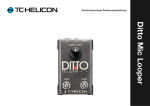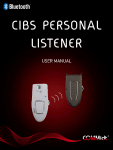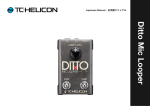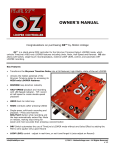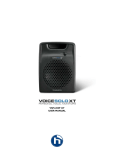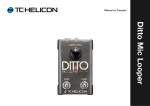Download Reference Manual - TC
Transcript
English Manual Ditto Mic Looper MP-75 Important safety instructions 1 EMC/EMI 2 Explanation of graphic symbols 2 About this manual 3 Introduction 3 Setup 4 Inputs, outputs, controls 1. Power input 2. MIC jack – Microphone input 3. OUT jack – Audio output 4. LOOP footswitch 5. STOP footswitch 6. LOOP LEVEL control knob 7. USB port Creating loops 8 8 8 8 8 8 8 8 Frequently asked questions 11 Footswitch LED state reference 11 Updating the firmware 11 Technical specifications 12 Getting support 12 9 Product Product (firmware) version Document Document version / date Ditto Mic Looper 1.0 English Manual 2014-11-17 Ditto Mic Looper English Manual – 2014-11-17a Important safety instructions 1. Read these instructions. 2. Keep these instructions. 3. Heed all warnings. 4. Follow all instructions. 5. Do not use this apparatus near water. 6. Clean only with a dry cloth. 7. Do not block any ventilation openings. Install in accordance with the manufacturer’s instructions. 8. Do not install near any heat sources such as radiators, heat registers, stoves, or other apparatus (including amplifiers) that produce heat. 9. Do not defeat the safety purpose of the polarized or grounding-type plug. A polarized plug has two blades with one wider than the other. A grounding-type plug has two blades and a third grounding prong. The wide blade or the third prong is provided for your safety. If the provided plug does not fit into your outlet, consult an electrician for replacement of the obsolete outlet. 10. Protect the power cord from being walked on or pinched, particularly at plugs, convenience receptacles, and the point where they exit from the apparatus. 11.Only use attachments/accessories specified by the manufacturer. 12. Use only with a cart, stand, tripod, bracket, or table specified by the manufacturer, or sold with the apparatus. When a cart is used, use caution when moving the cart/apparatus combination to avoid injury from tip-over. Important safety instructions 13.Unplug this apparatus during lightning storms or when unused for long periods of time. 14. Refer all servicing to qualified service personnel. Servicing is required when the apparatus has been damaged in any way, such as power-supply cord or plug is damaged, liquid has been spilled or objects have fallen into the apparatus, the apparatus has been exposed to rain or moisture, does not operate normally, or has been dropped. Caution You are cautioned that any change or modifications not expressly approved in this manual could void your authority to operate this equipment. Service ►►All service must be performed by qualified personnel. Warning ►►To reduce the risk of fire or electric shock, do not expose this apparatus to rain or moisture and objects filled with liquids, such as vases, should not be placed on this apparatus. ►►Do not install this device in a confined space. Ditto Mic Looper English Manual – 2014-11-171 Explanation of graphic symbols EMC/EMI Electromagnetic compatibility/ Electromagnetic interference This equipment has been tested and found to comply with the limits for a Class B digital device, pursuant to part 15 of the FCC rules. These limits are designed to provide reasonable protection against harmful interference in residential installations. This equipment generates, uses and can radiate radio frequency energy and, if not installed and used in accordance with the instructions, may cause harmful interference to radio communications. However, there is no guarantee that interference will not occur in a particular installation. Explanation of graphic symbols For customers in Canada This Class B digital apparatus complies with Canadian ICES-003. The lightning bolt triangle is used to alert the user to the presence of uninsulated “dangerous voltages” within the unit’s chassis that may be of sufficient magnitude to constitute a risk of electric shock to humans. The exclamation point triangle is used to alert the user to presence of important operating and service instructions in the literature accompanying the product. Cet appareil numérique de la classe B est conforme à la norme NMB-003 du Canada. If this equipment does cause harmful interference to radio or television reception, which can be determined by turning the equipment off and on, the user is encouraged to try to correct the interference by one or more of the following measures: ►►Reorient or relocate the receiving antenna. ►►Increase the separation between the equip- ment and receiver. ►►Connect the equipment into an outlet on a circuit different from that to which the receiver is connected. ►►Consult the dealer or an experienced radio/TV technician for help. Ditto Mic Looper English Manual – 2014-11-172 Introduction About this manual Introduction This manual will teach you everything you need to know to make great loops with your new Ditto Mic Looper. Thank you for purchasing Ditto Mic Looper. This manual is only available as a PDF download from the TC-Helicon website. Of course, you can print this manual, but we encourage you to use the PDF version, which has both internal and external hyperlinks. For example, clicking the TC-Helicon logo in the upper left corner of each page will take you to the table of contents. We’re super excited to be able to bring you such a simple and powerful looping pedal. If you can mic it, you can loop it. So get out there and record anything and everything… anything and everything… anything and everything… Features ►►Automatic mic gain ►►Five minutes of looping time ►►Unlimited overdubs ►►Overdub undo/redo ►►24 bit uncompressed high quality audio ►►Save loops over power cycles Thanks, The TC-Helicon Team To get the most from this manual, please read it from start to finish, or you may miss important information. To download the most current version of this manual, visit tc-helicon.com/products/ ditto-mic-looper/support/ Enjoy your TC-Helicon product. Ditto Mic Looper English Manual – 2014-11-173 Setup Setup Ready… Let’s get loopin’! The Ditto Mic Looper box should contain the following items: If you are in a hurry, chances are you’ll find what you’re looking for in this overview. ►►1 Ditto Mic Looper pedal ►►1 12 V / 400 mA power supply unit ►►1 “Quick Start Guide” sheet Operation Inspect all items for signs of transit damage. In the unlikely event of transit damage, inform the carrier and supplier. If damage has occurred, keep all packaging as it can be used as evidence of excessive handling force. Set… ►►Connect the power supply to Ditto Mic Loop- er. ►►Plug the power supply into a power outlet. ►►Connect your microphone to the MIC input jack on the rear of the pedal using an XLR cable. ►►Connect the OUT jack on the rear of the pedal to your PA using an XLR cable. ►►For more complex setups, see “Setup examples”. Power up Ditto Mic Looper Connect the included power supply. Record Tap the LOOP footswitch once. Switch to playback Tap the LOOP footswitch again. Undo/Redo last recording Press and hold the LOOP footswitch for 1.5 seconds. Stop Tap the STOP footswitch. Clear the loop Hold the STOP footswitch. Resume playback Tap the LOOP footswitch again. Mic Control You can control Ditto Mic Looper using TC-Helicon’s Mic Control technology! Simply connect a TC-Helicon MP-75 or Sennheiser e 835fx microphone to Ditto Mic Looper. If you use a condenser mic and the unit seems to “do stuff on its own”, go through the Mic Control process to ensure Mic Control is off. Mic Control should only be enabled if you are using a microphone supporting Mic Control. Mic Control features Record / Play / Overdub Stop Undo (during playback) Undo (while stopped) Stop and erase the loop Erase Press the microphone button. Double-press the microphone button. Press and hold the microphone button while playing. Press and hold the microphone button while playback is stopped. Please note that audio will be played back briefly before the last take is undone. Double-press and hold the microphone button while playing. Double-press and hold the microphone button while playback is stopped. Please note that audio will be played back briefly before the loop is erased. If you need to erase the loop silently, use Ditto Mic Looper’s STOP footswitch. ►►To enable Mic Control, press and hold the LOOP footswitch while powering up the unit. You should see the LED blink a couple of times to indicate the feature has been activated. ►►To turn Mic Control off, repeat the process. Ditto Mic Looper English Manual – 2014-11-174 Setup Setup examples Setup example 1: Basic looping – no effects This is the most basic setup: your microphone, Ditto Mic Looper and your PA. MP-75 Basic looping – no effects Ditto Mic Looper English Manual – 2014-11-175 Setup Setup example 2: Vocal effects before Ditto Mic Looper Place your vocal effect pedals before Ditto Mic Looper. This will allow you to create and record different sounds within the same looping session simply by switching your effects on and off. MP-75 Vocal effects before Ditto Mic Looper Ditto Mic Looper English Manual – 2014-11-176 Setup Setup example 3: Vocal effects after Ditto Mic Looper Place your vocal effect pedals after Ditto Mic Looper. This will allow you to record “dry” loops and dynamically apply vocal effects in real time. MP-75 Vocal effects after Ditto Mic Looper Ditto Mic Looper English Manual – 2014-11-177 Inputs, outputs, controls Inputs, outputs, controls 2 3 1 6 7 1. Power input 5. STOP footswitch Connect the included power supply to Ditto Mic Looper here. Use this footswitch to stop loop playback or to clear the loop. 2. MIC jack – Microphone input 6. LOOP LEVEL control knob This pedal has a standard XLR microphone input. If you are not using any vocal effects, connect your microphone here. For other setups, see “Setup examples”. Use the Loop level control knob to control the level of your loops. 3. OUT jack – Audio output This pedal has a standard XLR output. Connect the OUT jack to your PA using an XLR cable. If necessary (most of the time it’s not), adjust your mixer channel trim for the correct level according to your mixer’s instructions. For other setups, see “Setup examples”. 5 4 This control knob attenuates the signal – i.e., it turns the level down. If you turn the knob fully to the right, the loop will be played back at the same level it was recorded. 7. USB port Use the USB port to connect Ditto Mic Looper to a computer to update the device’s firmware. If firmware updates are released, you will find them at 4. LOOP footswitch tc-helicon.com/products/ ditto-mic-looper/support/ Use this footswitch to control all loop-related functions of the pedal (record, playback, undo/ redo). See “Creating loops”. For more information, see “Updating the firmware”. Ditto Mic Looper English Manual – 2014-11-178 Creating loops Creating loops Recording your first loop Overdubbing Redo (restoring a previously cleared take) Important: On the following pages, operation is described based on the default operation mode of Ditto Mic Looper (Record loop > Playback > Record overdubs). You can also use an alternative operation mode. See “Setting operation mode”. When you’re happy with your original loop, you can start overdubbing. If you have cleared (removed) the last take using Undo and you have changed your mind, you can restore that take. To do so, simply press and hold the LOOP footswitch for 1.5 seconds or longer during playback. To record another take (overdub), press the LOOP footswitch again while the original loop is playing back. The LOOP footswitch LED will turn red, indicating you’re in Record mode again. To start recording, press the LOOP footswitch once. The LED will light up in red, indicating Ditto Mic Looper is in Record mode. When you’re done, press the LOOP footswitch once more to quit Record mode. At the end of the loop (for example, after eight bars), press the LOOP footswitch again. Ditto Mic Looper will repeat the loop with both the original recording and the overdub. The LED will turn green, and Ditto Mic Looper will repeat the loop continuously. The LED will blink every time Ditto Mic Looper reaches the starting point of the loop. Please note that the length of the loop will never increase when overdubbing. When you continue recording, you will simply create additional overdubs. You can record as many overdubs as you like – there is no limit. Your loop can be up to five minutes long. Setting loop playback volume To change the playback volume of the loop you just recorded, adjust the LOOP LEVEL knob. The LOOP LEVEL knob only controls loop playback level – it has no influence on the signal from your microphone. Undo (clearing the last take) To undo the last take you recorded (i.e., remove it), simply press and hold the LOOP footswitch for 1.5 seconds or longer. You can undo the last take both during playback and when playback is stopped. The LED will blink twice in rapid succession, and the previously deleted take will be restored. Using Undo/Redo creatively Undoing and redoing overdubs can be used for more than just correcting mistakes. You can make your performance more interesting by removing and bringing back sections. Here is a simple example: ►►Sing a bass line (loop cycle 1). ►►Use a Harmony pedal (for example TC-Heli- con Harmony Singer) to create harmonies and record these (loop cycle 2). ►►Record a melody (loop cycle 3). ►►Press and hold the LOOP footswitch to clear the last take, i.e., remove the melody. Improvise or record something else. ►►Press and hold the LOOP footswitch again to bring back the previously cleared melody. The LED will blink twice in rapid succession, and the last take will be cleared (removed). Previously recorded takes will stay intact. Ditto Mic Looper English Manual – 2014-11-179 Creating loops Stopping loop playback/recording Stopping loop playback/ recording and deleting the loop To stop recording, press the LOOP footswitch once. To stop loop playback/recording and delete everything you have recorded, press and hold the STOP footswitch. To stop loop playback, press the STOP footswitch. The LED will start flashing in green to indicate that your loop is still in memory and ready for playback. Please note that it takes three seconds until the loop is actually deleted. Setting operation mode (“Record loop > Playback > Record” overdubs versus “Record loop > Record overdubs > Play”) Looping means creating music in real-time. This process should be fun and intuitive. But one guy’s “intuitive” is another guy’s “weird”. This is why we give you the opportunity to choose your preferred method. The LED will turn off to indicate that the loop has been deleted. At this point, you can start recording loops from scratch again. Some musicians prefer this workflow: Other than clearing the last overdub (which can be undone), deleting the full loop as described in this section cannot be undone! 1.Press a footswitch to start recording. 2.Press it again to switch to playback. 3.Press it a third time to create additional takes (overdubs). This is Ditto Mic Looper’s default mode. Other people prefer this method: 1.Press a footswitch to start recording. 2.Press it again to switch from recording your original loop to creating additional takes (overdubs) right away. 3.Press it a third time to go to playback. With Ditto Mic Looper, you can choose your preferred method. To switch to the alternative operation mode (“Record loop > Record overdubs > Play”), do this: ►►Power up Ditto Mic Looper while holding both switches. Repeat the process to return to the other mode. Ditto Mic Looper English Manual – 2014-11-1710 Frequently asked questions “Where should I place Ditto Mic Looper in my signal chain?” To get the most out of your setup and the loops you’re recording, place Ditto Mic Looper at the end of your signal chain. This gives you the flexibility to add parts with or without signal processing by simply switching effects on and off as required. For more information, see “Setup examples”. “How much loop time can I get out of Ditto Mic Looper ?” Ditto Mic Looper provides five minutes of looping time. “What’s the maximum number of overdubs that I can record?” Our guess is that you will tire out before Ditto Mic Looper does. Ditto Mic Looper allows an unlimited number of overdubs – so do your worst! “I made a mistake – how do I undo a part?” Press and hold the LOOP footswitch on Ditto Mic Looper while it is playing back your recorded loop. The last part you recorded will be removed. Updating the firmware Footswitch LED state reference Use this section as a reference when you are not sure what the current LED status means. LOOP footswitch LED… Off Device disconnected or no loop in memory Blinking green Loop in memory, playback/ recording stopped Green Loop running (LED will blink shortly when LOOP end is reached) Red Loop recording Blinking red Loop currently being erased Updating the firmware TC-Helicon may provide updates for the built-in software of your pedal, the firmware. Updating your TC-Helicon pedal’s firmware requires… ►►a computer running Microsoft Windows or OS X with a standard USB interface ►►the DC power supply that came with the pedal. Preparing the firmware update 1.Download the newest firmware from tc-helicon.com/products/ ditto-mic-looper/support/ There are updaters… – for Microsoft Windows (these are ZIP archives containing the firmware installer) and – for OS X (these are disk image files containing the firmware installer). 2.Unplug all cables (including the power supply) from your Ditto Mic Looper. 3.Connect the pedal to your computer using a USB cable. 4.Hold down the LOOP footswitch. 5.Connect the power supply. The LED will light solid green. 6.Release the footswitch. Ditto Mic Looper will now be recognized as an updatable device. Ditto Mic Looper English Manual – 2014-11-1711 Applying the firmware update 7.Quit all MIDI-related applications (e.g. your DAW) on your computer and launch the firmware updater you have downloaded in step 1. 8.In the firmware updater app, select “Ditto Boot” from the drop-down list under the “STEP 1” heading. If you are using Windows XP, select “USB Audio Device” from the list. 9.When the “Update” button under the “STEP 2” heading turns green, click it. The updated firmware will now be transferred to Ditto Mic Looper. Wait for the progress bar to reach 100%. When the update procedure is complete, the pedal will automatically restart. Getting support Technical specifications Getting support ►►Maximum loop length: 5 minutes ►►Maximum number of overdubs: Unlimited ►►Dimensions (Width x depth x height): If you still have questions about the product after reading this manual and the FAQ page, please get in touch with TC-Helicon Support: 135 mm x 113 mm x 54 mm / 5.31” x 4.44” x 2.13 ►►Weight: 512 g / 1.13 lbs. ►►Input connector: XLR ►►Output connector: XLR ►►Power input: 12 V DC, center negative ►►USB connector type: Mini-B USB ►►Controls: ►►Loop level knob ►►Loop footswitch ►►Stop footswitch http://tc-helicon.com/support/ Due to continuous development, these specifications are subject to change without notice. Ditto Mic Looper English Manual – 2014-11-1712 Ditto Mic Looper English Manual – 2014-11-1713















